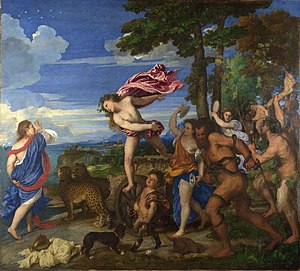Bacchus and Ariadne
| Bacchus and Ariadne | |
|---|---|
 |
|
| Artist | Titian |
| Year | 1522–23 |
| Type | oil on canvas (applied onto conservation board 1968) |
| Dimensions | 176.5 cm × 191 cm (69.5 in × 75 in) |
| Location | National Gallery, London |
Bacchus and Ariadne (1522–1523) is an oil painting by Titian. It is one of a cycle of paintings on mythological subjects produced for Alfonso I d'Este, Duke of Ferrara, for the Camerino d'Alabastro – a private room in his palazzo in Ferrara decorated with paintings based on classical texts. An advance payment was given to Raphael, who originally held the commission for the subject of a Triumph of Bacchus. At the time of Raphael's death in 1520, only a preliminary drawing was completed and the commission was then handed to Titian. In the case of Bacchus and Ariadne, the subject matter was derived from the Roman poets Catullus and Ovid. The painting, considered one of Titian's greatest works, now hangs in the National Gallery in London. The other major paintings in the cycle are The Feast of the Gods (mostly by Giovanni Bellini, now in the National Gallery of Art, Washington, D.C), and Titian's The Bacchanal of the Andrians and The Worship of Venus (both now in the Museo del Prado, Madrid).
Ariadne has been left on the island of Naxos, deserted by her lover Theseus, whose ship sails away to the far left. She is discovered on the shore by the god Bacchus, leading a procession of revelers in a chariot drawn by two cheetahs (These were probably modelled on those in the Duke's menagerie and were tigers in Ovid's original text). Bacchus is depicted in mid-air as he leaps out of the chariot to protect Ariadne from these beasts. In the sky above the figure of Ariadne is the star constellation Corona Borealis (Northern crown). There are two possible variations of the story both going back to Ovid. In his Metamorphoses, Ovid has Bacchus throw the crown of Ariadne into the sky where it becomes the constellation Northern Crown. In Ars Amatoria, Bacchus promises the entire sky to Ariadne where she then would become the constellation Northern Crown. The National Gallery's website states that in the painting, 'Bacchus, god of wine, emerges with his followers from the landscape to the right. Falling in love with Ariadne on first sight, he leaps from his chariot, drawn by two cheetahs, towards her. Ariadne had been abandoned on the Greek island of Naxos by Theseus, whose ship is shown in the distance. The picture shows her initial fear of Bacchus, but he raised her to heaven and turned her into a constellation, represented by the stars above her head.'
...
Wikipedia
